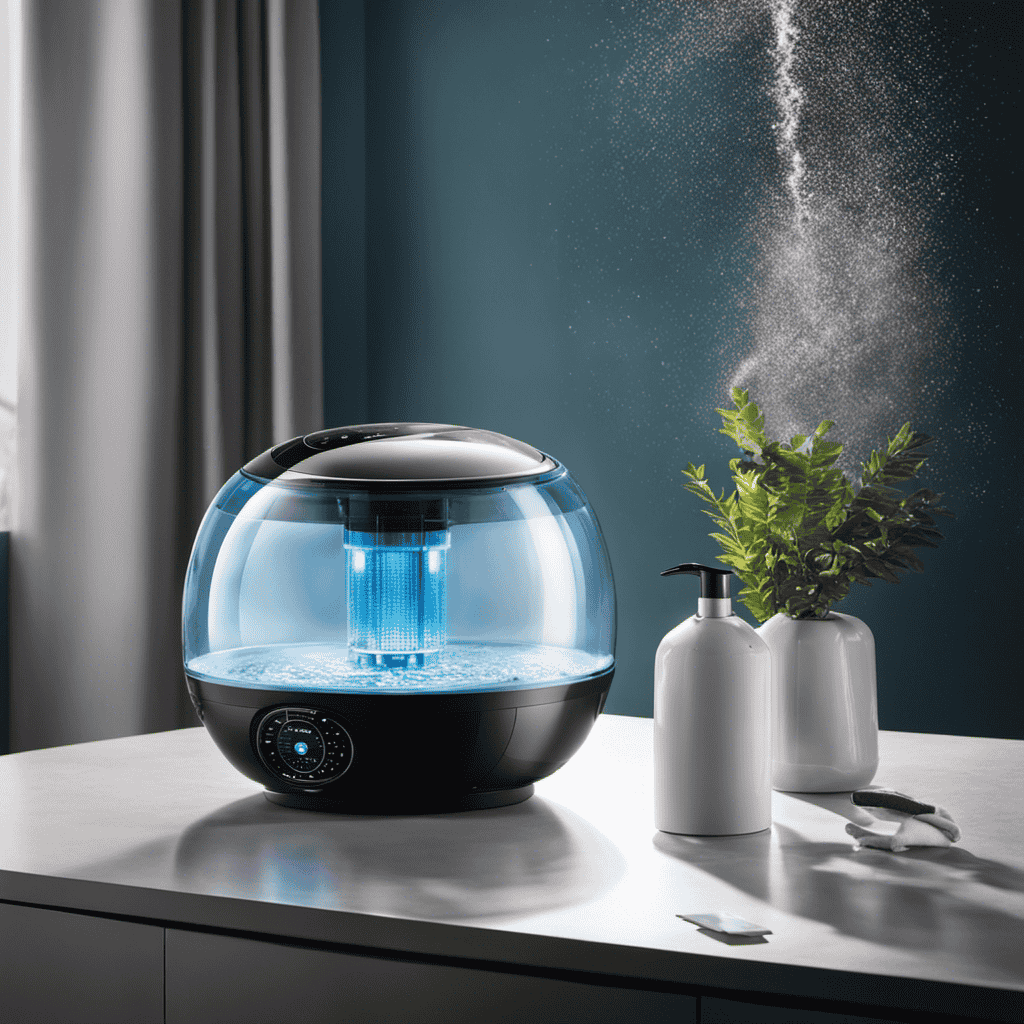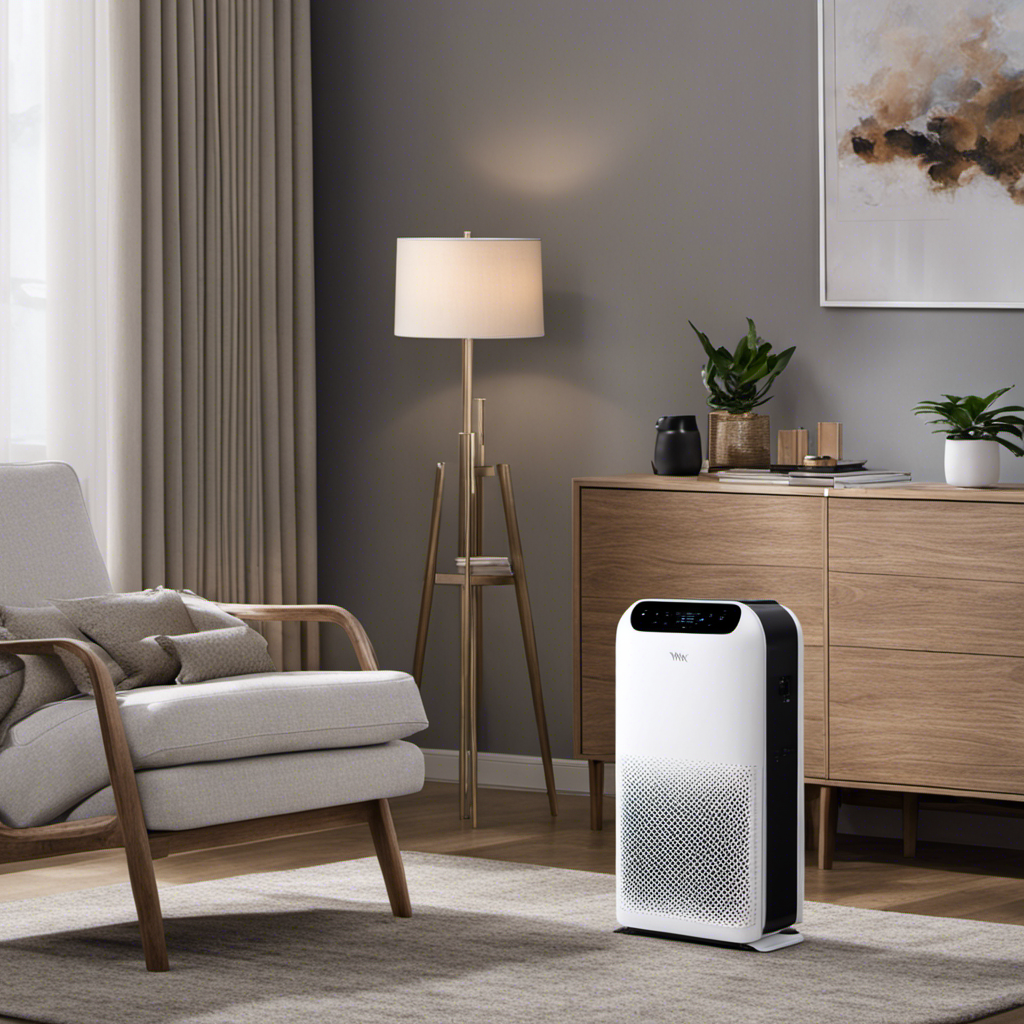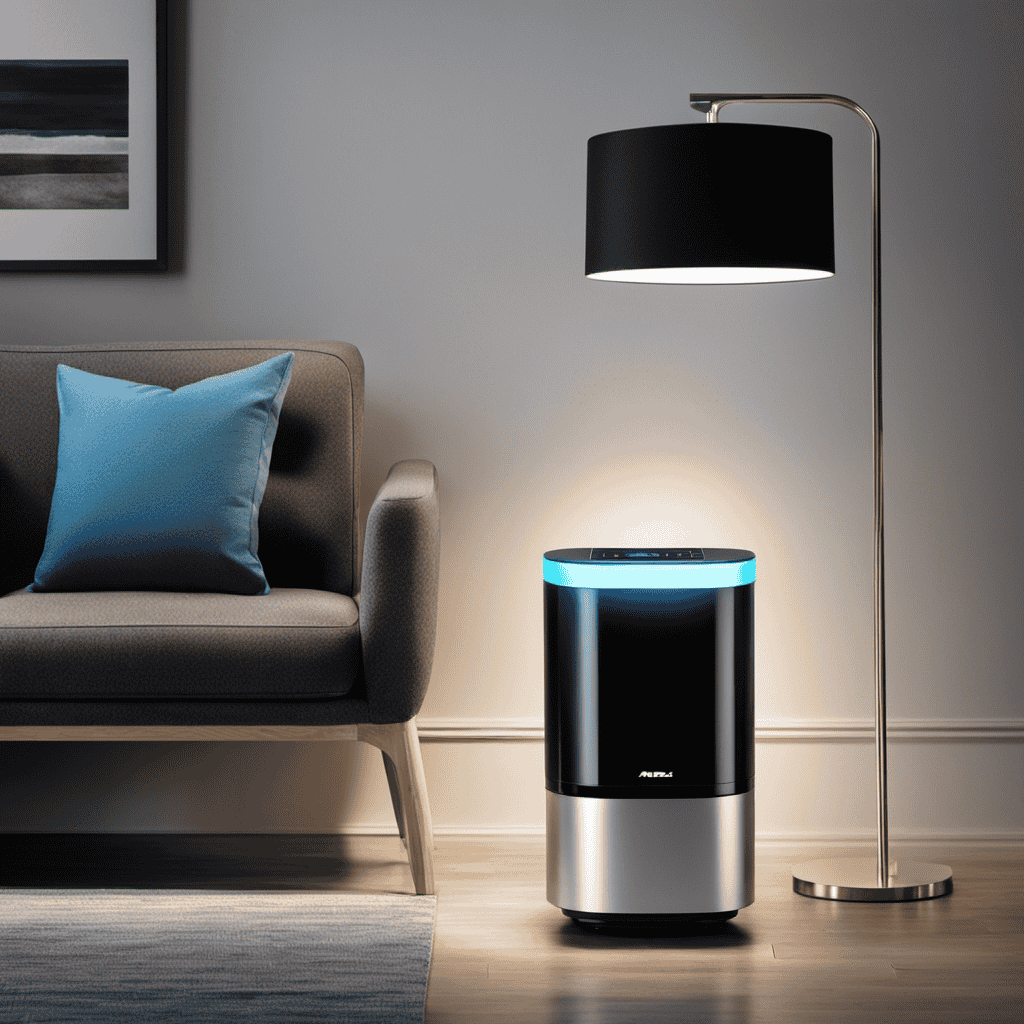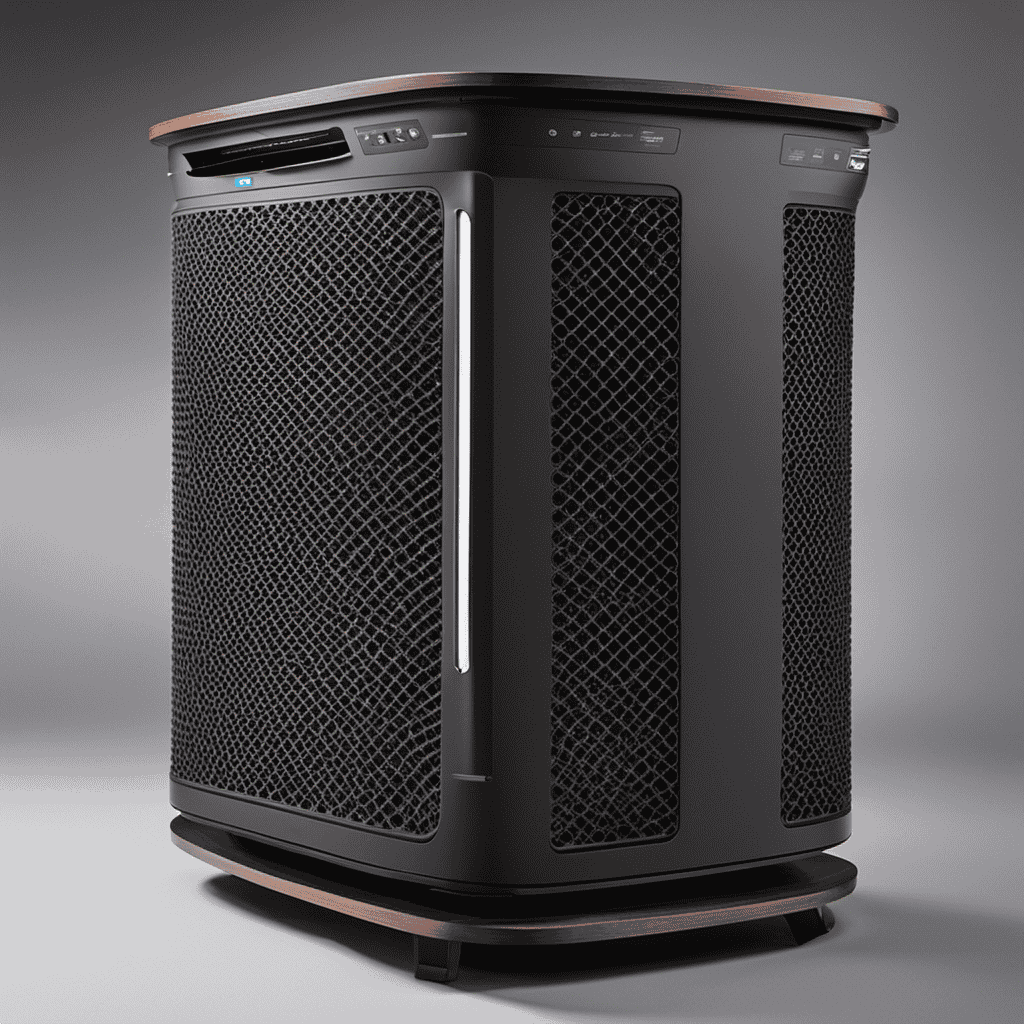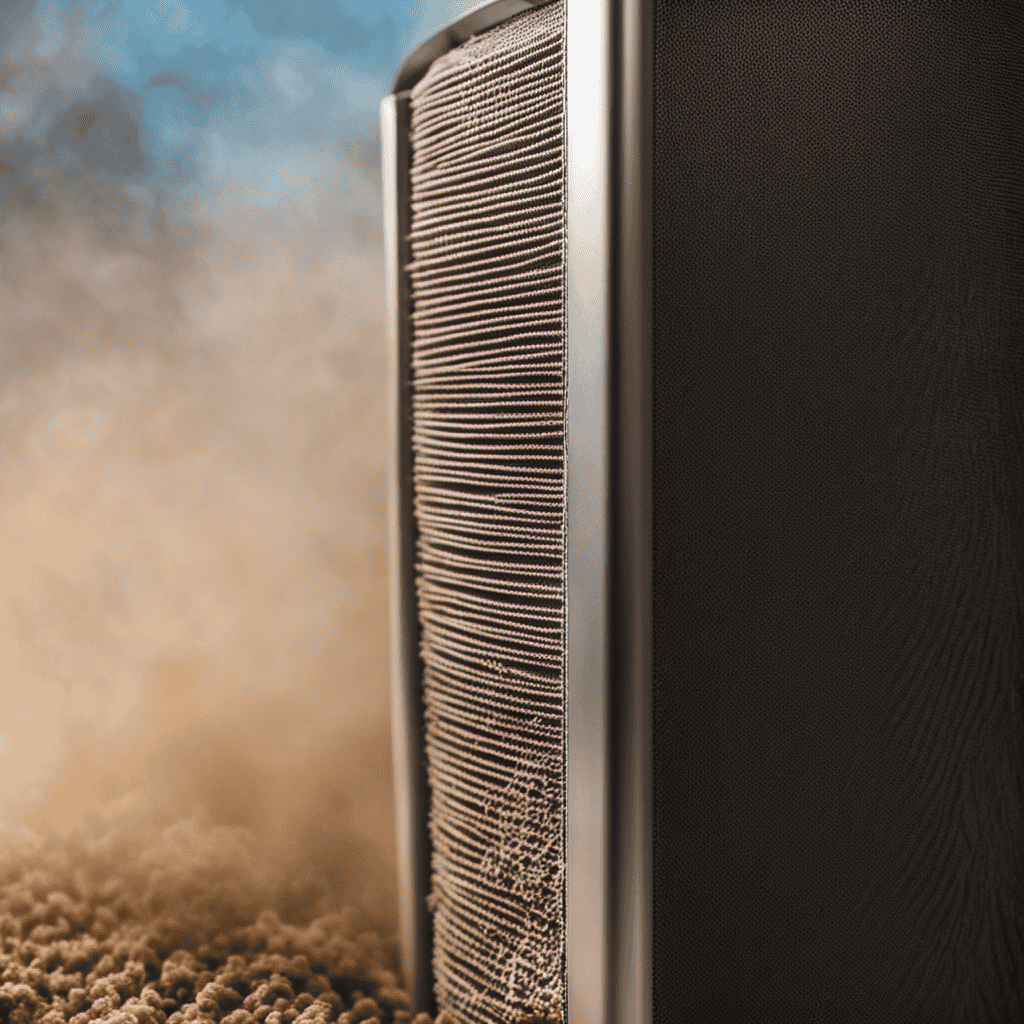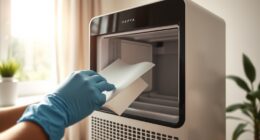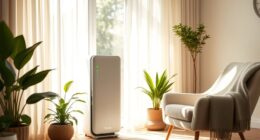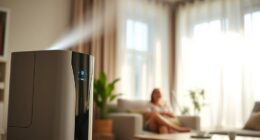Did you realize that the air inside your home could be up to 5 times more contaminated than the air outside? That’s why it’s essential to have a high-quality water air purifier in your home.
In this article, I will guide you through the importance of regular cleaning for your water air purifier, signs that indicate it needs cleaning, and the step-by-step cleaning process.
I’ll also provide you with recommended cleaning frequencies, tips for maintaining a clean purifier, and common mistakes to avoid.
Let’s get started!
Key Takeaways
- Indoor air can be up to 5 times more polluted than outdoor air.
- Regular cleaning maintains the efficiency and effectiveness of the water air purifier.
- Foul odor indicates a buildup of bacteria or mold.
- Regular maintenance is important for optimal performance.
Importance of Regular Cleaning
You should make sure to regularly clean your water air purifier to maintain its efficiency and effectiveness.
Cleaning your water air purifier at the right frequency brings several benefits. Firstly, it ensures that the purifier is able to effectively remove airborne pollutants, such as dust, pet dander, and allergens, from the air in your home. Regular cleaning prevents the accumulation of these pollutants in the purifier, allowing it to continue functioning optimally.
Secondly, cleaning your water air purifier helps to prevent the growth of mold and bacteria, which can thrive in the moist environment of the purifier. This is especially important for individuals with respiratory conditions or allergies.
When it comes to cleaning methods, it’s important to follow the manufacturer’s instructions. Typically, it involves cleaning the water tank, filter, and other removable parts with mild soap and water, and replacing the filter as recommended.
Signs That Your Water Air Purifier Needs Cleaning
As a water air purifier owner, it’s important to be aware of the signs that indicate when your device needs cleaning.
One of the key indicators is a foul odor emanating from the purifier. This suggests that there may be a buildup of bacteria or mold inside.
Additionally, if you notice a decreased air flow or visible dirt and debris in the water tank or filter, it’s a clear indication that your water air purifier is in need of a thorough cleaning to ensure optimal performance.
Foul Odor Indicates Cleaning
The foul odor you’re experiencing indicates that it’s time to clean the water air purifier. Regular maintenance is crucial to ensure the efficient functioning of the purifier and to maintain clean and fresh air in your surroundings. Cleaning the purifier helps in reducing foul odors and preventing bacterial growth.
Here are three important steps to follow when cleaning your water air purifier:
-
Empty and clean the water tank: Remove any remaining water and thoroughly clean the tank using a mild detergent. Rinse it well to remove any residue.
-
Clean or replace the filter: Depending on the type of filter your purifier has, clean it according to the manufacturer’s instructions or replace it if necessary. This ensures optimal performance.
-
Disinfect the unit: Use a disinfectant solution to clean the internal components of the purifier, including the fan and vents, to eliminate any bacteria or mold growth.
Decreased Air Flow
To address decreased air flow, it’s important to check and clean the vents and fan of your purifier regularly. When air flow becomes restricted, it can impact the effectiveness of your purifier in removing pollutants from the air. Increased maintenance and a regular cleaning schedule are necessary to ensure optimal performance.
Start by inspecting the vents for any obstructions such as dust or pet hair. Use a soft cloth or brush to gently remove any buildup. Next, clean the fan blades to prevent them from becoming clogged with dirt. This will help maintain a steady and unrestricted airflow.
By incorporating these cleaning practices into your routine, you can ensure that your purifier operates efficiently and effectively to provide you with clean and fresh air.
Now, let’s move on to the next section about visible dirt or debris.
Visible Dirt or Debris
Check for any noticeable dirt or debris on the exterior of your purifier, as it can accumulate over time and affect its performance. Regular cleaning is essential to maintain the efficiency of your water air purifier.
Here are some maintenance tips to keep in mind:
- Cleaning frequency: Depending on the manufacturer’s instructions, you may need to clean your purifier every 2-4 weeks.
- Use a soft cloth or brush to remove dirt and debris from the exterior. Avoid using harsh chemicals that could damage the purifier.
- Clean the filters regularly to prevent clogging and ensure optimal air purification.
Regularly checking for dirt or debris on your purifier is crucial to ensure that it is functioning at its best. Now, let’s move on to the step-by-step cleaning process to keep your purifier in top condition.
Step-by-Step Cleaning Process
Start by unplugging the water air purifier and removing any filters or components that can be cleaned separately.
To effectively clean the water air purifier, you will need a few essential cleaning products. The best cleaning products for this task include a mild detergent, vinegar, and a soft brush or cloth. These products will help remove any built-up dirt and grime from the purifier.
The cleaning process itself should take approximately 30 minutes, depending on the level of dirtiness. Begin by wiping down the exterior of the purifier with a damp cloth. Then, disassemble the filters and wash them with a mild detergent. Rinse thoroughly and allow them to dry completely before reassembling the purifier.
Cleaning the water tank requires draining the water and using a mixture of vinegar and water to remove any mineral deposits. Let the solution sit for a few minutes before scrubbing the tank with a soft brush. Rinse thoroughly and dry before refilling with fresh water.
Remember to follow the manufacturer’s instructions for any additional cleaning steps specific to your purifier model.
Recommended Cleaning Frequency
Now that we know the step-by-step cleaning process for a water air purifier, let’s discuss how often it should be cleaned. Regular maintenance is essential to ensure the optimal performance of your purifier.
Here are the recommended cleaning frequencies and methods:
-
Weekly Cleaning:
-
Use a soft cloth or sponge to wipe the exterior of the purifier.
-
Empty and clean the water tank using mild soap and water.
-
Rinse and dry all removable parts thoroughly before reassembling.
-
Monthly Cleaning:
-
Disassemble the purifier and clean each component separately.
-
Soak the filter in a mixture of water and vinegar to remove any stubborn residue.
-
Rinse all parts thoroughly and allow them to air dry before reassembling.
-
Yearly Maintenance:
-
Replace the filter with a new one to maintain the purifier’s efficiency.
-
Inspect the purifier for any signs of wear and tear and address them accordingly.
Tips for Maintaining a Clean Water Air Purifier
When it comes to maintaining a clean water air purifier, it is important to consider both the recommended cleaning frequency and the best cleaning techniques.
The cleaning frequency recommendations vary depending on the specific model and usage, but generally, it is recommended to clean the purifier at least once every two weeks.
As for the best cleaning techniques, it is crucial to follow the manufacturer’s instructions and use mild cleaning solutions to ensure the longevity and optimal performance of the purifier.
Cleaning Frequency Recommendations
To keep your water air purifier running efficiently, you should clean it at least once every three months. Regular cleaning is essential for maintaining the performance and effectiveness of your purifier.
Here are some cleaning methods and the benefits of regular cleaning:
-
Cleaning Methods:
-
Remove the water tank and empty it completely.
-
Use a mild detergent and warm water to clean the tank.
-
Rinse thoroughly to remove any soap residue.
-
Clean the filter by gently brushing or vacuuming it.
-
Benefits of Regular Cleaning:
-
Ensures the removal of dust, allergens, and pollutants from the air.
-
Prevents the growth of mold and bacteria in the water tank.
-
Improves the overall air quality in your home.
-
Extends the lifespan of your water air purifier.
Best Cleaning Techniques
For optimal results with your water air purifier, it’s best to utilize these cleaning techniques.
When it comes to cleaning your water air purifier, using the best cleaning products is crucial. Look for cleaning solutions that are specifically designed for air purifiers, as they are formulated to effectively remove dirt, dust, and other contaminants without damaging the unit.
Additionally, having the right cleaning tools and equipment is essential. A soft cloth or sponge can be used to gently wipe down the exterior and interior surfaces of the purifier. A small brush can help reach crevices and corners that are difficult to clean with a cloth.
Remember to follow the manufacturer’s instructions for cleaning and avoid using abrasive materials or harsh chemicals.
By using the proper cleaning techniques and tools, you can ensure that your water air purifier continues to function at its best.
Now, let’s explore some common mistakes to avoid when cleaning.
Common Mistakes to Avoid When Cleaning
One of the common mistakes to avoid when cleaning a water air purifier is forgetting to unplug it. This step is crucial to ensure your safety while handling electrical appliances.
In addition to this, there are a few other mistakes that people often make when cleaning their water air purifiers:
-
Using harsh chemicals: It is important to avoid using strong chemicals as they can damage the sensitive components of the purifier.
-
Neglecting the water tank: Regularly cleaning and disinfecting the water tank is essential to prevent the growth of bacteria and mold.
-
Not replacing filters: Filters play a vital role in purifying the air. It is important to follow the manufacturer’s instructions and replace them regularly.
Frequently Asked Questions
Can I Use Any Type of Cleaning Solution to Clean My Water Air Purifier?
Yes, you can use vinegar to clean your water air purifier. It is a safe and effective cleaning solution. However, there are alternative cleaning solutions such as hydrogen peroxide or a mixture of lemon juice and water that can also be used.
Is It Necessary to Clean the Water Tank of My Water Air Purifier?
It is necessary to clean the water tank of my water air purifier. Cleaning the tank ensures optimal performance and prevents the growth of bacteria. Using tap water is safe, and the benefits of a water air purifier include increased humidity and trapping of larger particles.
How Do I Know if My Water Air Purifier Is Working Effectively?
I know my water air purifier is working effectively by troubleshooting common issues like low airflow or strange odors. Using a water air purifier has benefits over other types, such as trapping more pollutants.
Can I Clean the Filters of My Water Air Purifier With Water?
I clean the filters of my water air purifier with water whenever they become dirty, which usually happens every few months. However, there are alternative cleaning methods available, such as using a vacuum or a brush.
How Long Does It Take for a Water Air Purifier to Dry After Cleaning?
After cleaning a water air purifier, it typically takes a few hours for it to dry completely. To maintain optimal performance, it is recommended to clean the purifier regularly. The benefits of using a water air purifier include improved air quality and reduced allergens.
Conclusion
In conclusion, regular cleaning of your water air purifier is crucial for maintaining its efficiency and effectiveness in purifying the air in your home. Neglecting this task can lead to a buildup of dirt, bacteria, and other contaminants, which can hinder the performance of the purifier and even pose health risks.
Just like how we need to clean our bodies to stay healthy, our water air purifiers require proper maintenance to ensure they function optimally. Remember, a clean purifier equals clean air, and that’s something we all deserve.
